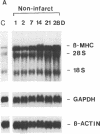Abstract
Continued adverse remodeling of myocardium after infarction may lead to progressive ventricular dilation and heart failure. We tested the hypothesis that exercise training in a healed myocardial infarction-dysfunction rat model can favorably modify the adverse effects of ventricular remodeling including attenuation of abnormal myosin gene expression. Sprague-Dawley rats were subjected to either proximal LAD ligation or sham operation. At 5 wk after the operation, animals were randomly assigned to sedentary conditions or 6 wk of graduated swim training, creating four experimental groups: infarct sedentary (IS), infarct exercise (IE), sham sedentary (SS), and sham exercise (SE). At 11 wk all rats were sacrificed and analyzed. Compared to sedentary infarct controls, exercise training attenuated left ventricular (LV) dilation and allowed more hypertrophy of the non infarct wall. The exercise-trained hearts also showed a reduction in the estimated peak wall tension. Northern blot analysis showed an increase in beta-myosin heavy chain expression in the hearts of the sedentary infarction group soon after infarction when compared to sham controls. However, with exercise training, there was a significant attenuation of the beta-myosin heavy chain expression in the myocardium. Exercise training in a model of left ventricular dysfunction after healed myocardial infarction can improve the adverse remodeling process by attenuating ventricular dilation and reducing wall tension. The abnormal beta-myosin expression was also attenuated in the exercise trained group. This is evidence that abnormal gene expression following severe myocardial infarction dysfunction can be favorably modified by an intervention.
Full text
PDF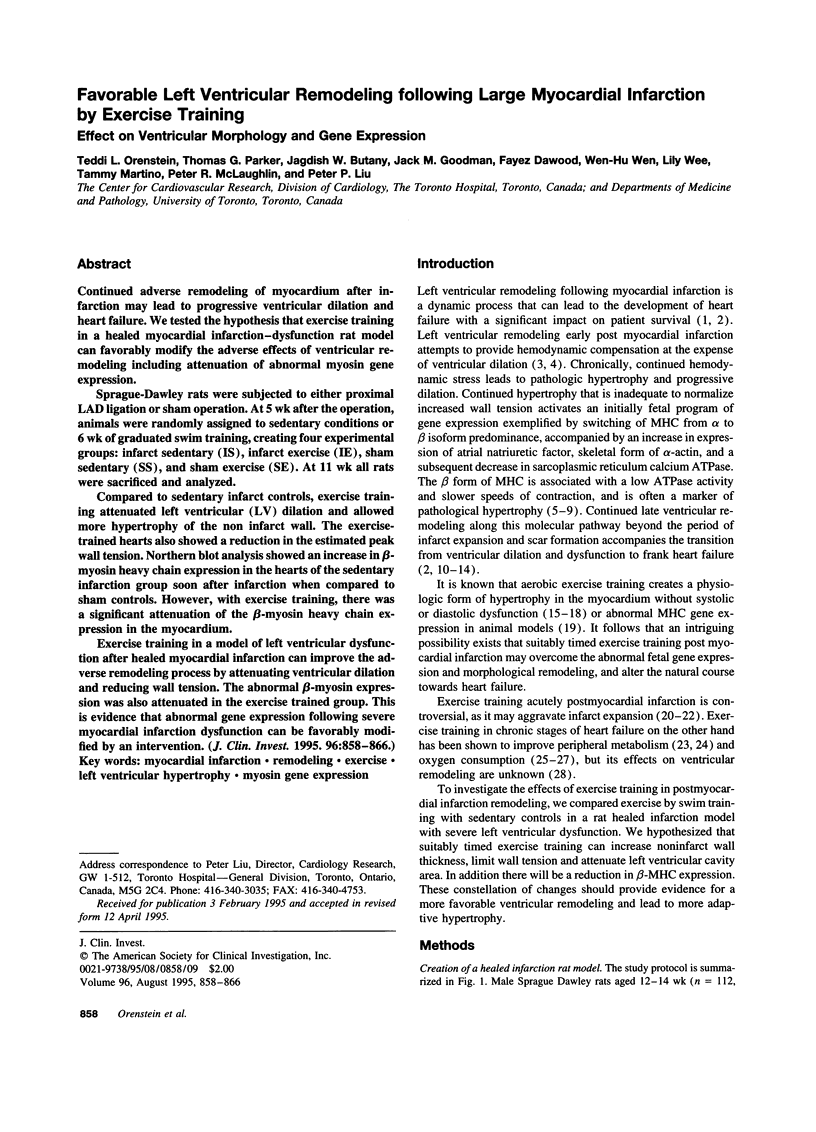
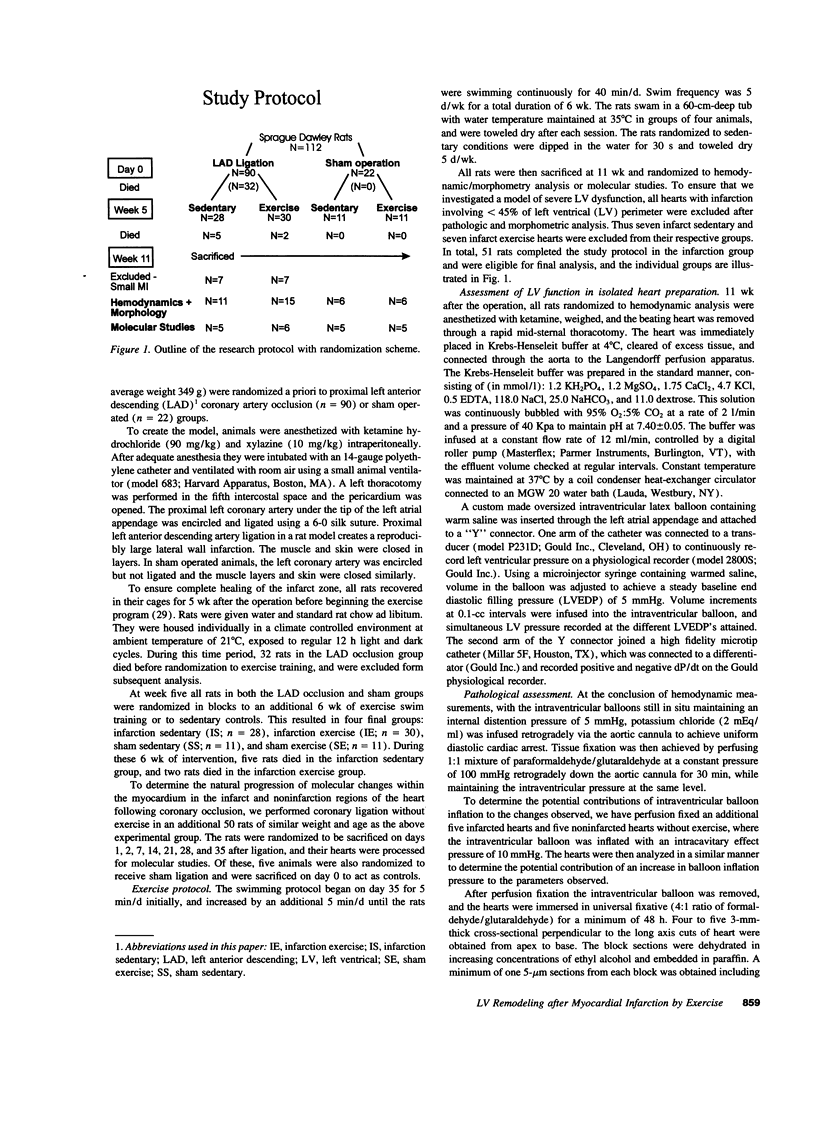
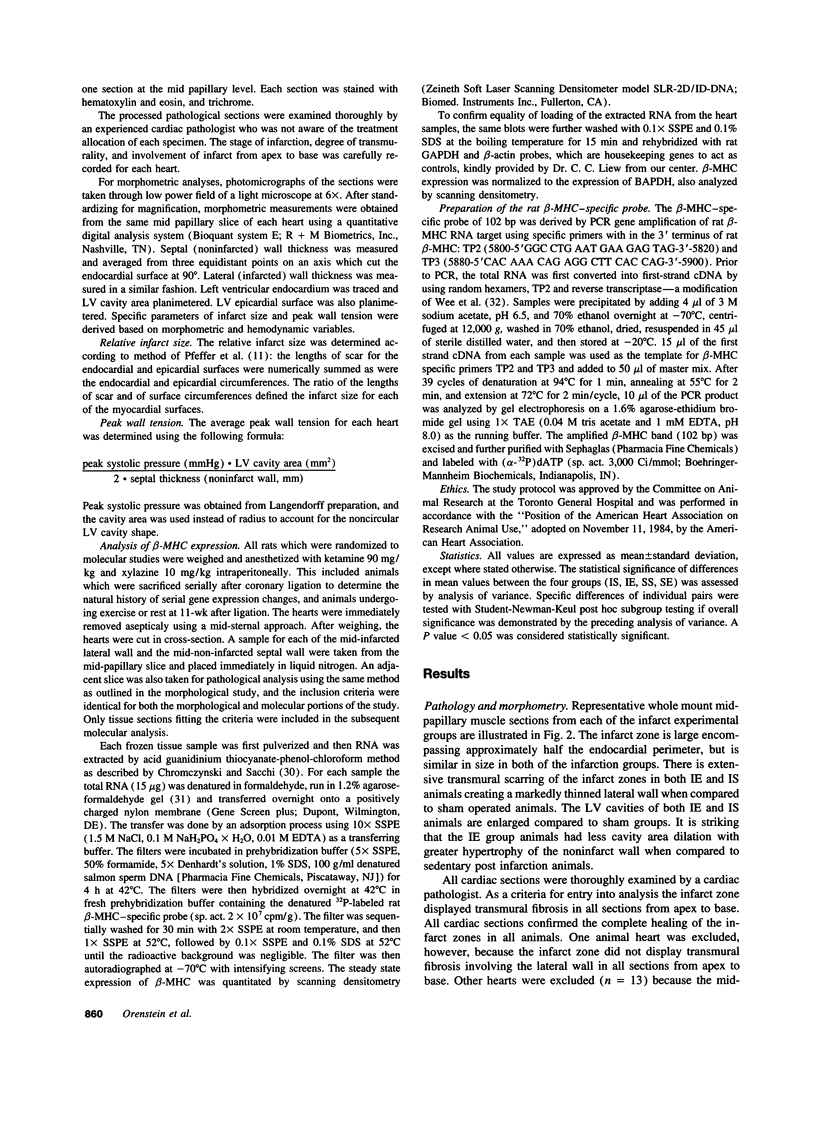
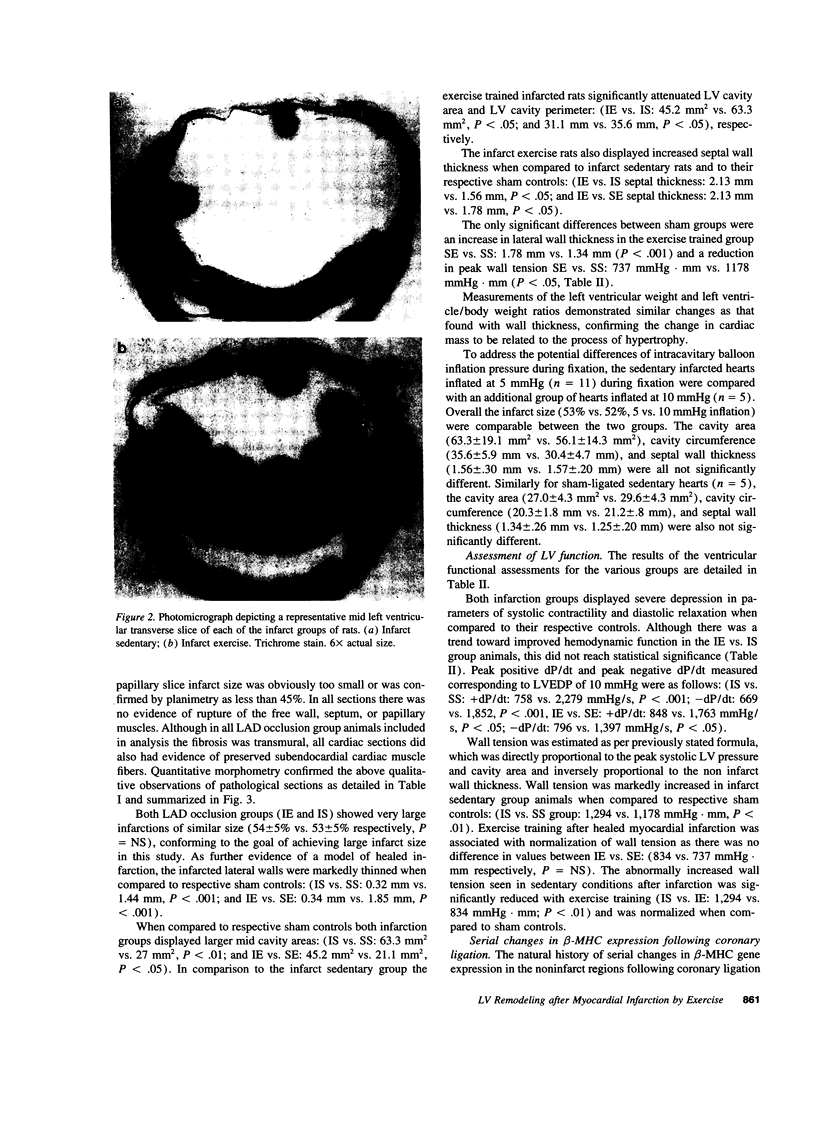
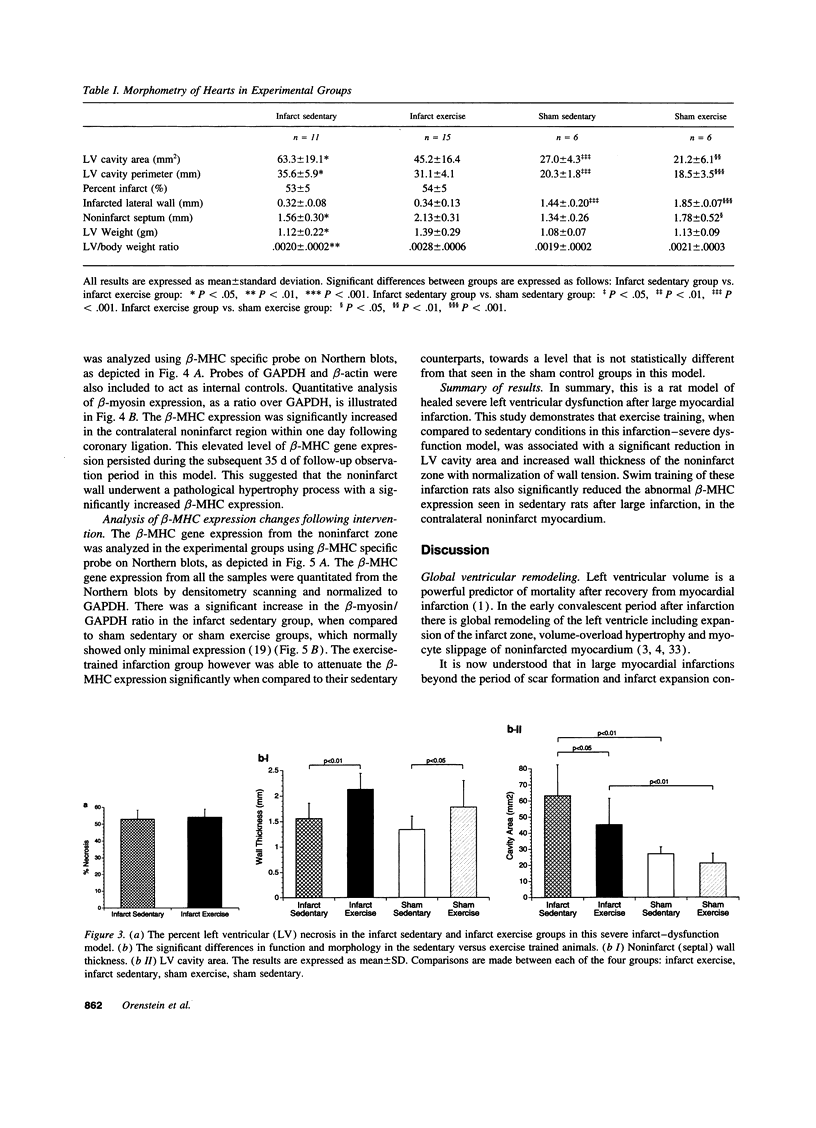
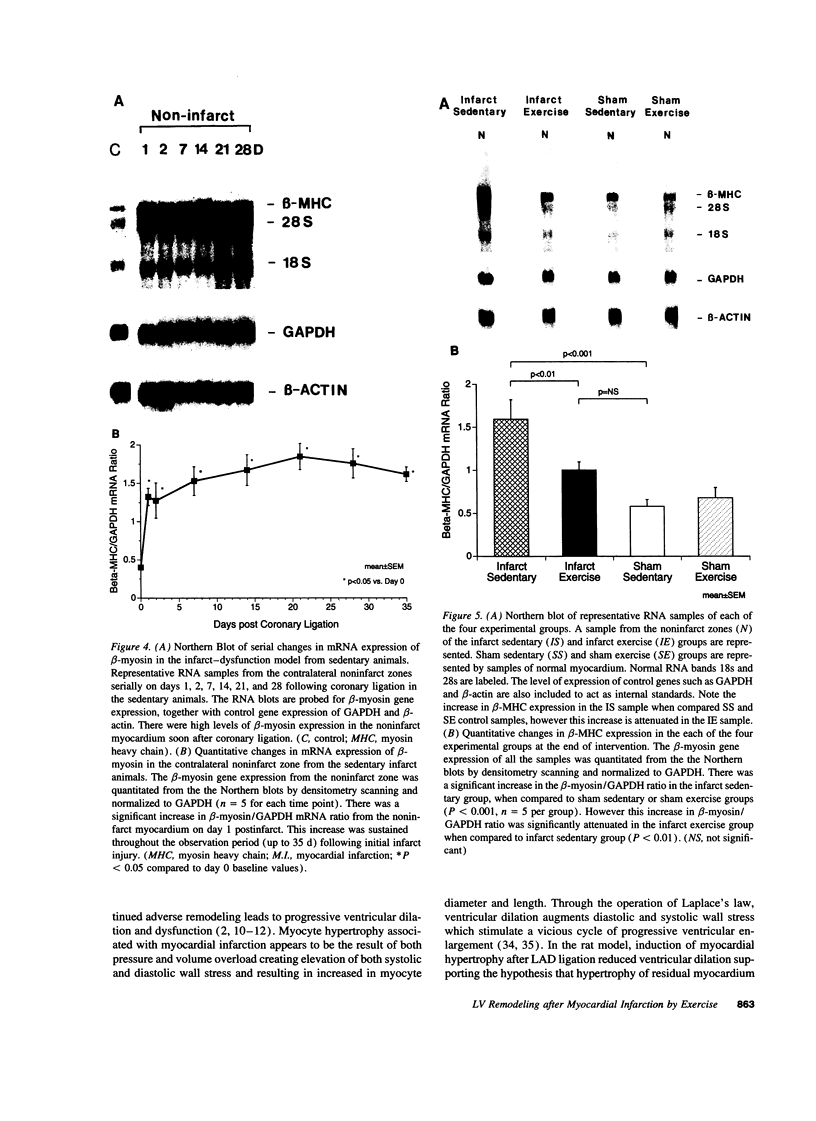
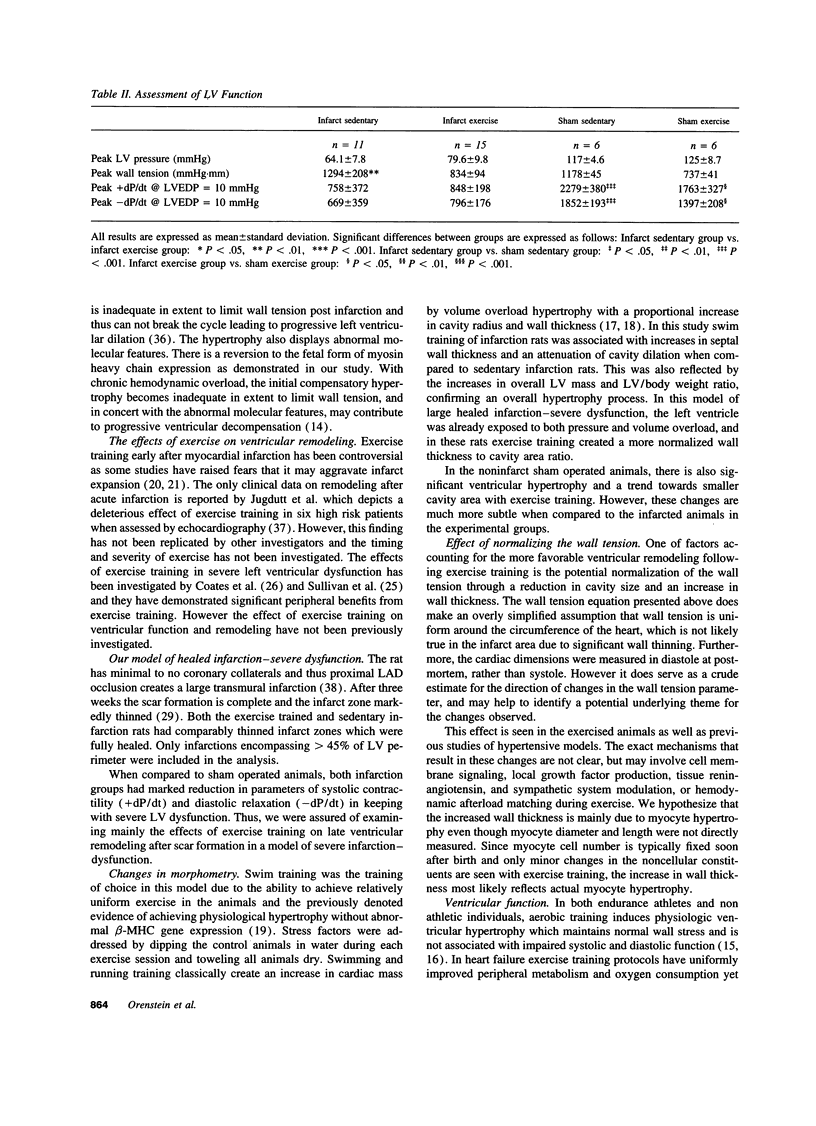
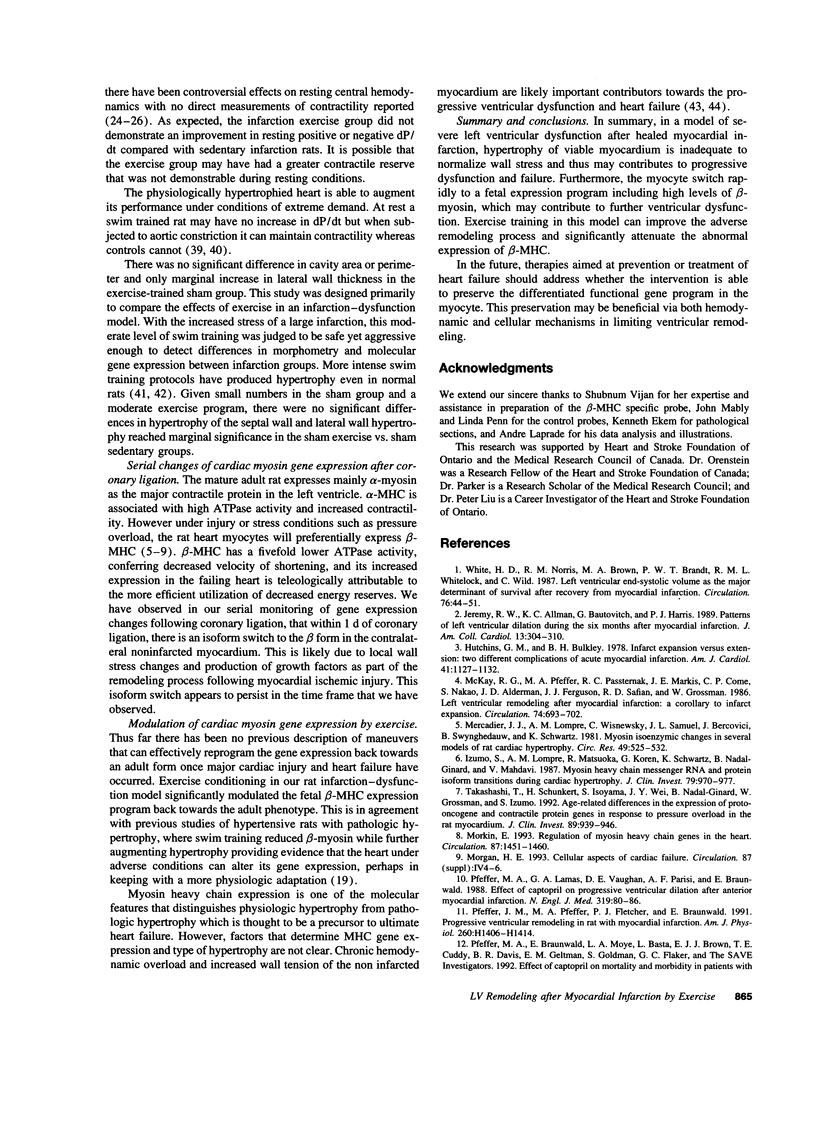
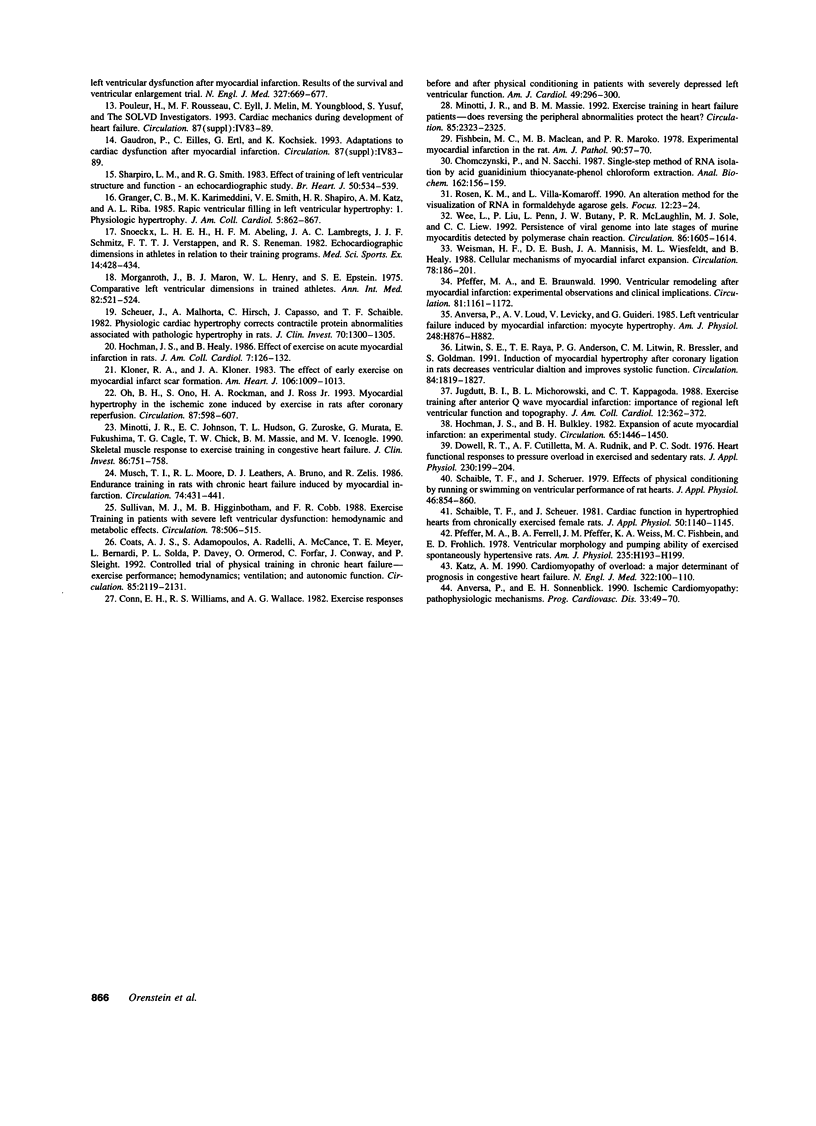
Images in this article
Selected References
These references are in PubMed. This may not be the complete list of references from this article.
- Anversa P., Loud A. V., Levicky V., Guideri G. Left ventricular failure induced by myocardial infarction. I. Myocyte hypertrophy. Am J Physiol. 1985 Jun;248(6 Pt 2):H876–H882. doi: 10.1152/ajpheart.1985.248.6.H876. [DOI] [PubMed] [Google Scholar]
- Anversa P., Sonnenblick E. H. Ischemic cardiomyopathy: pathophysiologic mechanisms. Prog Cardiovasc Dis. 1990 Jul-Aug;33(1):49–70. doi: 10.1016/0033-0620(90)90039-5. [DOI] [PubMed] [Google Scholar]
- Chomczynski P., Sacchi N. Single-step method of RNA isolation by acid guanidinium thiocyanate-phenol-chloroform extraction. Anal Biochem. 1987 Apr;162(1):156–159. doi: 10.1006/abio.1987.9999. [DOI] [PubMed] [Google Scholar]
- Coats A. J., Adamopoulos S., Radaelli A., McCance A., Meyer T. E., Bernardi L., Solda P. L., Davey P., Ormerod O., Forfar C. Controlled trial of physical training in chronic heart failure. Exercise performance, hemodynamics, ventilation, and autonomic function. Circulation. 1992 Jun;85(6):2119–2131. doi: 10.1161/01.cir.85.6.2119. [DOI] [PubMed] [Google Scholar]
- Conn E. H., Williams R. S., Wallace A. G. Exercise responses before and after physical conditioning in patients with severely depressed left ventricular function. Am J Cardiol. 1982 Feb 1;49(2):296–300. doi: 10.1016/0002-9149(82)90504-5. [DOI] [PubMed] [Google Scholar]
- Dowell R. T., Cutilletta A. F., Rudnik M. A., Sodt P. C. Heart functional responses to pressure overload in exercised and sedentary rats. Am J Physiol. 1976 Jan;230(1):199–204. doi: 10.1152/ajplegacy.1976.230.1.199. [DOI] [PubMed] [Google Scholar]
- Fishbein M. C., Maclean D., Maroko P. R. Experimental myocardial infarction in the rat: qualitative and quantitative changes during pathologic evolution. Am J Pathol. 1978 Jan;90(1):57–70. [PMC free article] [PubMed] [Google Scholar]
- Granger C. B., Karimeddini M. K., Smith V. E., Shapiro H. R., Katz A. M., Riba A. L. Rapid ventricular filling in left ventricular hypertrophy: I. Physiologic hypertrophy. J Am Coll Cardiol. 1985 Apr;5(4):862–868. doi: 10.1016/s0735-1097(85)80424-1. [DOI] [PubMed] [Google Scholar]
- Hochman J. S., Bulkley B. H. Expansion of acute myocardial infarction: an experimental study. Circulation. 1982 Jun;65(7):1446–1450. doi: 10.1161/01.cir.65.7.1446. [DOI] [PubMed] [Google Scholar]
- Hochman J. S., Healy B. Effect of exercise on acute myocardial infarction in rats. J Am Coll Cardiol. 1986 Jan;7(1):126–132. doi: 10.1016/s0735-1097(86)80269-8. [DOI] [PubMed] [Google Scholar]
- Hutchins G. M., Bulkley B. H. Infarct expansion versus extension: two different complications of acute myocardial infarction. Am J Cardiol. 1978 Jun;41(7):1127–1132. doi: 10.1016/0002-9149(78)90869-x. [DOI] [PubMed] [Google Scholar]
- Izumo S., Lompré A. M., Matsuoka R., Koren G., Schwartz K., Nadal-Ginard B., Mahdavi V. Myosin heavy chain messenger RNA and protein isoform transitions during cardiac hypertrophy. Interaction between hemodynamic and thyroid hormone-induced signals. J Clin Invest. 1987 Mar;79(3):970–977. doi: 10.1172/JCI112908. [DOI] [PMC free article] [PubMed] [Google Scholar]
- Jeremy R. W., Allman K. C., Bautovitch G., Harris P. J. Patterns of left ventricular dilation during the six months after myocardial infarction. J Am Coll Cardiol. 1989 Feb;13(2):304–310. doi: 10.1016/0735-1097(89)90503-2. [DOI] [PubMed] [Google Scholar]
- Jugdutt B. I., Michorowski B. L., Kappagoda C. T. Exercise training after anterior Q wave myocardial infarction: importance of regional left ventricular function and topography. J Am Coll Cardiol. 1988 Aug;12(2):362–372. doi: 10.1016/0735-1097(88)90407-x. [DOI] [PubMed] [Google Scholar]
- Katz A. M. Cardiomyopathy of overload. A major determinant of prognosis in congestive heart failure. N Engl J Med. 1990 Jan 11;322(2):100–110. doi: 10.1056/NEJM199001113220206. [DOI] [PubMed] [Google Scholar]
- Kloner R. A., Kloner J. A. The effect of early exercise on myocardial infarct scar formation. Am Heart J. 1983 Nov;106(5 Pt 1):1009–1013. doi: 10.1016/0002-8703(83)90645-2. [DOI] [PubMed] [Google Scholar]
- Litwin S. E., Raya T. E., Anderson P. G., Litwin C. M., Bressler R., Goldman S. Induction of myocardial hypertrophy after coronary ligation in rats decreases ventricular dilatation and improves systolic function. Circulation. 1991 Oct;84(4):1819–1827. doi: 10.1161/01.cir.84.4.1819. [DOI] [PubMed] [Google Scholar]
- McKay R. G., Pfeffer M. A., Pasternak R. C., Markis J. E., Come P. C., Nakao S., Alderman J. D., Ferguson J. J., Safian R. D., Grossman W. Left ventricular remodeling after myocardial infarction: a corollary to infarct expansion. Circulation. 1986 Oct;74(4):693–702. doi: 10.1161/01.cir.74.4.693. [DOI] [PubMed] [Google Scholar]
- Mercadier J. J., Lompré A. M., Wisnewsky C., Samuel J. L., Bercovici J., Swynghedauw B., Schwartz K. Myosin isoenzyme changes in several models of rat cardiac hypertrophy. Circ Res. 1981 Aug;49(2):525–532. doi: 10.1161/01.res.49.2.525. [DOI] [PubMed] [Google Scholar]
- Minotti J. R., Johnson E. C., Hudson T. L., Zuroske G., Murata G., Fukushima E., Cagle T. G., Chick T. W., Massie B. M., Icenogle M. V. Skeletal muscle response to exercise training in congestive heart failure. J Clin Invest. 1990 Sep;86(3):751–758. doi: 10.1172/JCI114771. [DOI] [PMC free article] [PubMed] [Google Scholar]
- Minotti J. R., Massie B. M. Exercise training in heart failure patients. Does reversing the peripheral abnormalities protect the heart? Circulation. 1992 Jun;85(6):2323–2325. doi: 10.1161/01.cir.85.6.2323. [DOI] [PubMed] [Google Scholar]
- Morganroth J., Maron B. J., Henry W. L., Epstein S. E. Comparative left ventricular dimensions in trained athletes. Ann Intern Med. 1975 Apr;82(4):521–524. doi: 10.7326/0003-4819-82-4-521. [DOI] [PubMed] [Google Scholar]
- Morkin E. Regulation of myosin heavy chain genes in the heart. Circulation. 1993 May;87(5):1451–1460. doi: 10.1161/01.cir.87.5.1451. [DOI] [PubMed] [Google Scholar]
- Musch T. I., Moore R. L., Leathers D. J., Bruno A., Zelis R. Endurance training in rats with chronic heart failure induced by myocardial infarction. Circulation. 1986 Aug;74(2):431–441. doi: 10.1161/01.cir.74.2.431. [DOI] [PubMed] [Google Scholar]
- Oh B. H., Ono S., Rockman H. A., Ross J., Jr Myocardial hypertrophy in the ischemic zone induced by exercise in rats after coronary reperfusion. Circulation. 1993 Feb;87(2):598–607. doi: 10.1161/01.cir.87.2.598. [DOI] [PubMed] [Google Scholar]
- Pfeffer J. M., Pfeffer M. A., Fletcher P. J., Braunwald E. Progressive ventricular remodeling in rat with myocardial infarction. Am J Physiol. 1991 May;260(5 Pt 2):H1406–H1414. doi: 10.1152/ajpheart.1991.260.5.H1406. [DOI] [PubMed] [Google Scholar]
- Pfeffer M. A., Braunwald E., Moyé L. A., Basta L., Brown E. J., Jr, Cuddy T. E., Davis B. R., Geltman E. M., Goldman S., Flaker G. C. Effect of captopril on mortality and morbidity in patients with left ventricular dysfunction after myocardial infarction. Results of the survival and ventricular enlargement trial. The SAVE Investigators. N Engl J Med. 1992 Sep 3;327(10):669–677. doi: 10.1056/NEJM199209033271001. [DOI] [PubMed] [Google Scholar]
- Pfeffer M. A., Braunwald E. Ventricular remodeling after myocardial infarction. Experimental observations and clinical implications. Circulation. 1990 Apr;81(4):1161–1172. doi: 10.1161/01.cir.81.4.1161. [DOI] [PubMed] [Google Scholar]
- Pfeffer M. A., Ferrell B. A., Pfeffer J. M., Weiss A. K., Fishbein M. C., Frohlich E. D. Ventricular morphology and pumping ability of exercised spontaneously hypertensive rats. Am J Physiol. 1978 Aug;235(2):H193–H199. doi: 10.1152/ajpheart.1978.235.2.H193. [DOI] [PubMed] [Google Scholar]
- Pfeffer M. A., Lamas G. A., Vaughan D. E., Parisi A. F., Braunwald E. Effect of captopril on progressive ventricular dilatation after anterior myocardial infarction. N Engl J Med. 1988 Jul 14;319(2):80–86. doi: 10.1056/NEJM198807143190204. [DOI] [PubMed] [Google Scholar]
- Schaible T. F., Scheuer J. Cardiac function in hypertrophied hearts from chronically exercised female rats. J Appl Physiol Respir Environ Exerc Physiol. 1981 Jun;50(6):1140–1145. doi: 10.1152/jappl.1981.50.6.1140. [DOI] [PubMed] [Google Scholar]
- Schaible T. F., Scheuer J. Effects of physical training by running or swimming on ventricular performance of rat hearts. J Appl Physiol Respir Environ Exerc Physiol. 1979 Apr;46(4):854–860. doi: 10.1152/jappl.1979.46.4.854. [DOI] [PubMed] [Google Scholar]
- Scheuer J., Malhotra A., Hirsch C., Capasso J., Schaible T. F. Physiologic cardiac hypertrophy corrects contractile protein abnormalities associated with pathologic hypertrophy in rats. J Clin Invest. 1982 Dec;70(6):1300–1305. doi: 10.1172/JCI110729. [DOI] [PMC free article] [PubMed] [Google Scholar]
- Shapiro L. M., Smith R. G. Effect of training on left ventricular structure and function. An echocardiographic study. Br Heart J. 1983 Dec;50(6):534–539. doi: 10.1136/hrt.50.6.534. [DOI] [PMC free article] [PubMed] [Google Scholar]
- Snoeckx L. H., Abeling H. F., Lambregts J. A., Schmitz J. J., Verstappen F. T., Reneman R. S. Echocardiographic dimensions in athletes in relation to their training programs. Med Sci Sports Exerc. 1982;14(6):428–434. doi: 10.1249/00005768-198206000-00004. [DOI] [PubMed] [Google Scholar]
- Sullivan M. J., Higginbotham M. B., Cobb F. R. Exercise training in patients with severe left ventricular dysfunction. Hemodynamic and metabolic effects. Circulation. 1988 Sep;78(3):506–515. doi: 10.1161/01.cir.78.3.506. [DOI] [PubMed] [Google Scholar]
- Takahashi T., Schunkert H., Isoyama S., Wei J. Y., Nadal-Ginard B., Grossman W., Izumo S. Age-related differences in the expression of proto-oncogene and contractile protein genes in response to pressure overload in the rat myocardium. J Clin Invest. 1992 Mar;89(3):939–946. doi: 10.1172/JCI115675. [DOI] [PMC free article] [PubMed] [Google Scholar]
- Wee L., Liu P., Penn L., Butany J. W., McLaughlin P. R., Sole M. J., Liew C. C. Persistence of viral genome into late stages of murine myocarditis detected by polymerase chain reaction. Circulation. 1992 Nov;86(5):1605–1614. doi: 10.1161/01.cir.86.5.1605. [DOI] [PubMed] [Google Scholar]
- Weisman H. F., Bush D. E., Mannisi J. A., Weisfeldt M. L., Healy B. Cellular mechanisms of myocardial infarct expansion. Circulation. 1988 Jul;78(1):186–201. doi: 10.1161/01.cir.78.1.186. [DOI] [PubMed] [Google Scholar]
- White H. D., Norris R. M., Brown M. A., Brandt P. W., Whitlock R. M., Wild C. J. Left ventricular end-systolic volume as the major determinant of survival after recovery from myocardial infarction. Circulation. 1987 Jul;76(1):44–51. doi: 10.1161/01.cir.76.1.44. [DOI] [PubMed] [Google Scholar]





